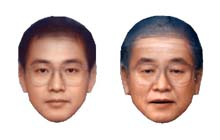 |
 |
 |
 |
 |
 |
|||||
 |
 |
 |
 |
|
FACE FASCINATION: More to the Face Than Meets the Eye September 17, 1999  Digitized composites reveal the average face of a bank employee (left) and a politician. (Harashima Laboratory, University of Tokyo) The human face has lately been garnering quite a bit of attention. It is the basis for identity and is every bit as important to communication as are words. Over the past four and a half years, academic societies devoted to studying the face from every possible angle have been springing up in Japan. A unique science exhibit called Dai-Kao-Ten (Great Exhibit of the Face), being held at the National Science Museum in Tokyo through October 17, presents some of the results of this ongoing research in a wide range of fields and probes into the face's mysteries. As well as offering engaging themes like the birth of the face, its evolution, and its future transformation, the show includes exhibits on masks of the world and the history of makeup and an area that provides training in good facial expressions. Faces in the Crowd Kohara is chairperson of the Japan Academy of Facial Studies, which was established in March 1995. At that time there were some who were critical of study devoted to the face, reasoning that character was more important than physical appearance. More than four years later, however, the membership has grown to over 700 individuals from a diverse mix of fields, including anthropology, medicine, engineering, psychology, dentistry, and cosmetology; there are even police officers and housewives among them. Close to 30% of the members are women, moreover, in a country where academic societies usually consist almost entirely of men. The interdisciplinary nature of all this research activity is leading to a new formula for academic study that is more accessible to the public. A forum was held in fall 1998, for instance, where anything related to the face was fair game. Included in the wide mix of provocative presentations were "changing ideals of the beautiful man and woman," "a comparison of the sense of facial beauty in China and Japan," "facial expressions from the perspective of a monkey," and "the faces of Japanese people in the movies." Fun with the Face The Average Face: Faces from members of a wide range of categories, such as bankers, pro wrestlers, politicians, and students from the Meiji era (1868-1912) and the present are compiled and processed in a computer, producing a typical face of each group. The results reveal that the characteristic features vary from one group to another and inspire the question: Do those with similar faces join the same profession, or does working in a particular field change one's face? A Biological Look at the Face: According to biologists, in ancient times the face was an organ for obtaining energy. Through the process of evolution the faces of primates, of all mammals, came to serve the function of communicating feelings and intentions. While people express their will explicitly through words, it is generally accepted that emotions are expressed as much through the eyes as the mouth. This is one reason why people devote so much attention to their faces. The Face of the Future: It is said that the facial features of the modern Japanese can be largely classified into those inherited from people of the Jomon period (ca. 10,000 B.C.-ca. 300 B.C.; though recent findings may stretch this date back by about four millennia) and those from people of the Yayoi period (ca. 300 B.C.-ca. A.D. 300). While there has been a face fetish of late that has been dubbed a "small face" boom, the Japanese face is in fact getting smaller. Based on anthropological estimates of its bone structure 100 years from now, the Japanese face is predicted to become significantly smaller and shaped like an inverted triangle.
|

